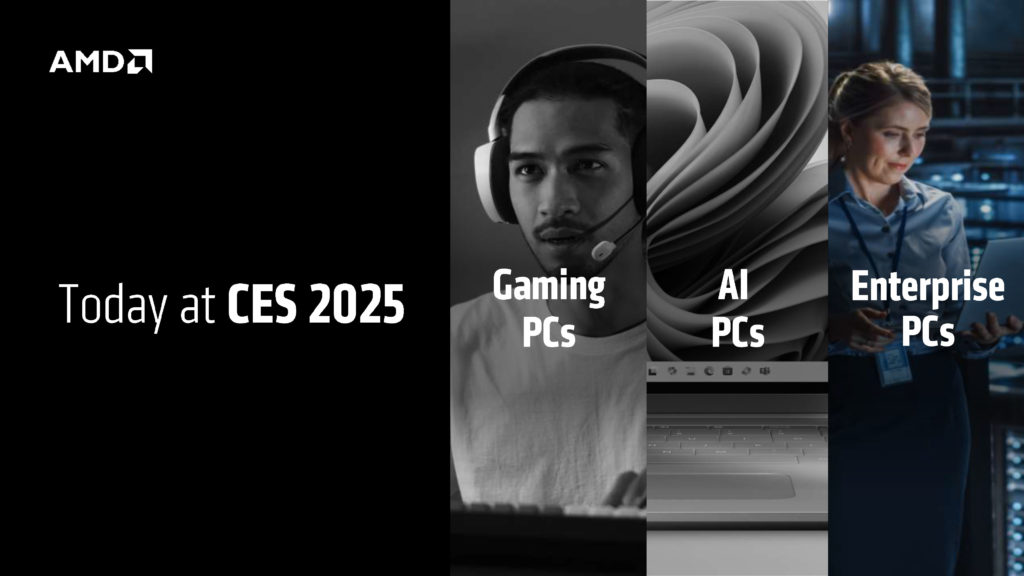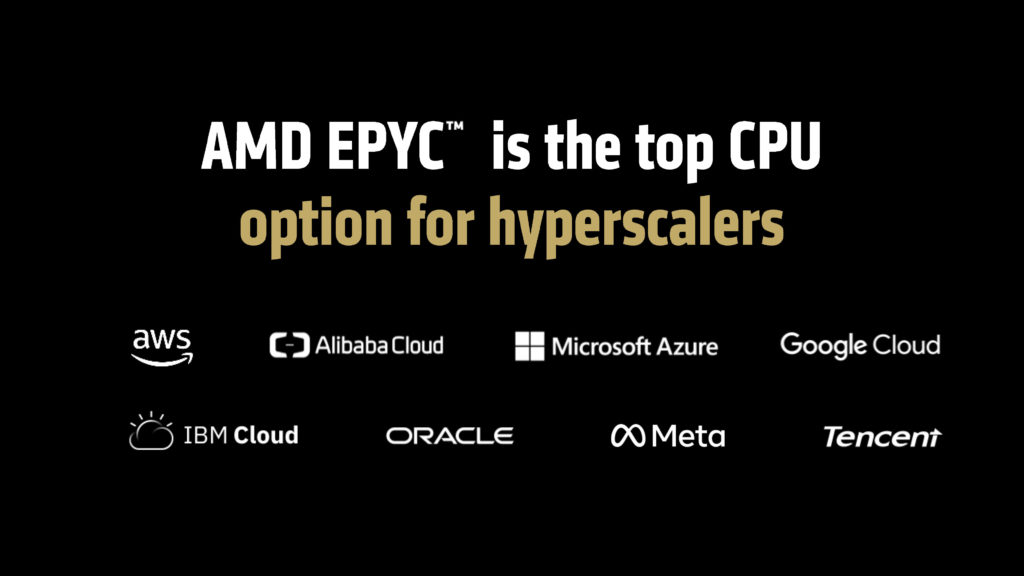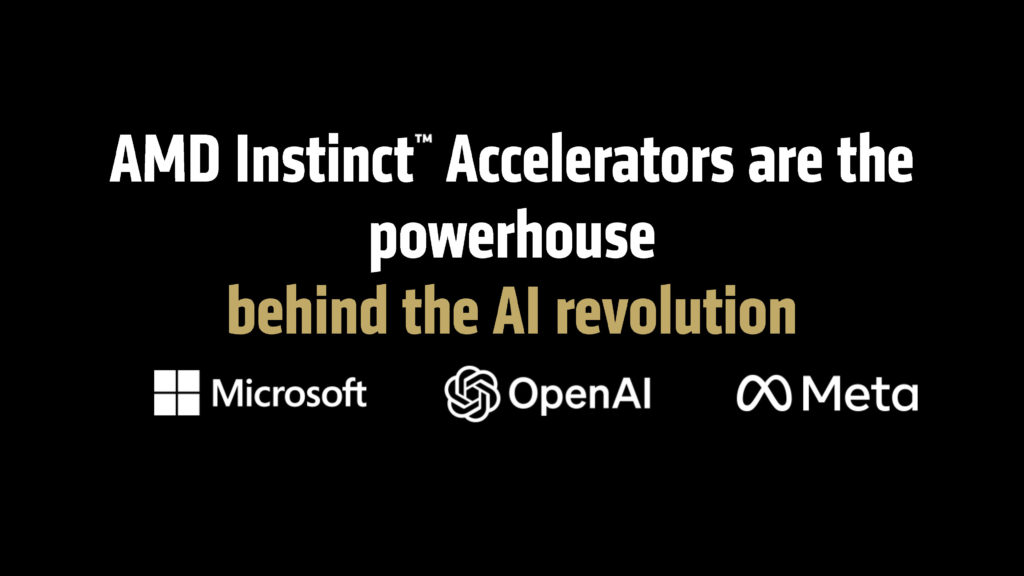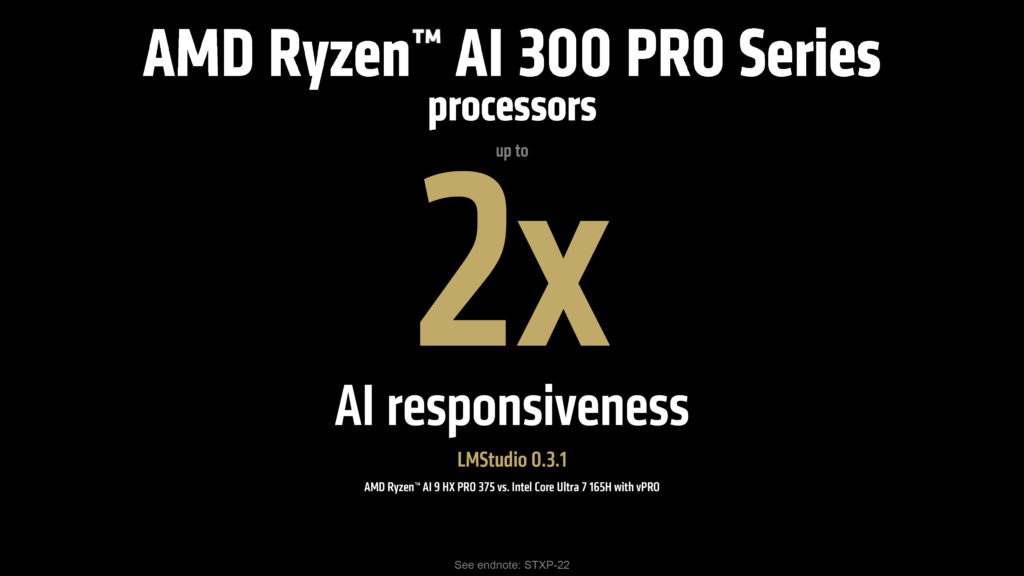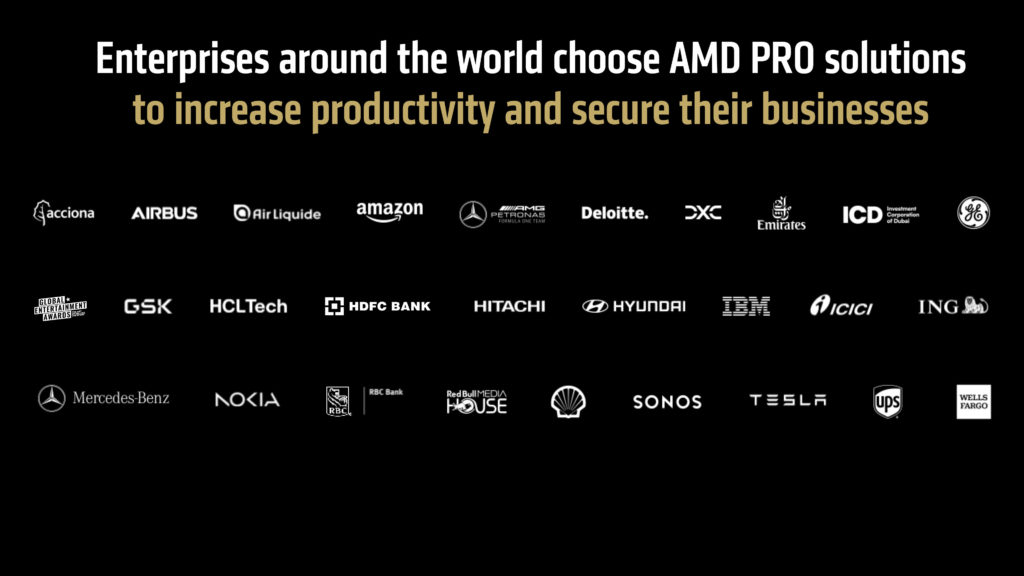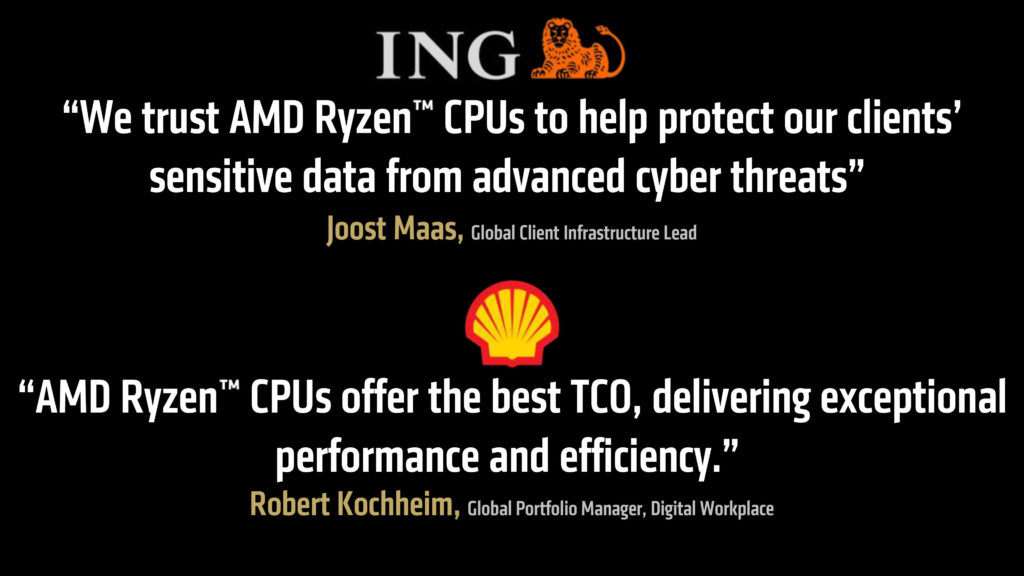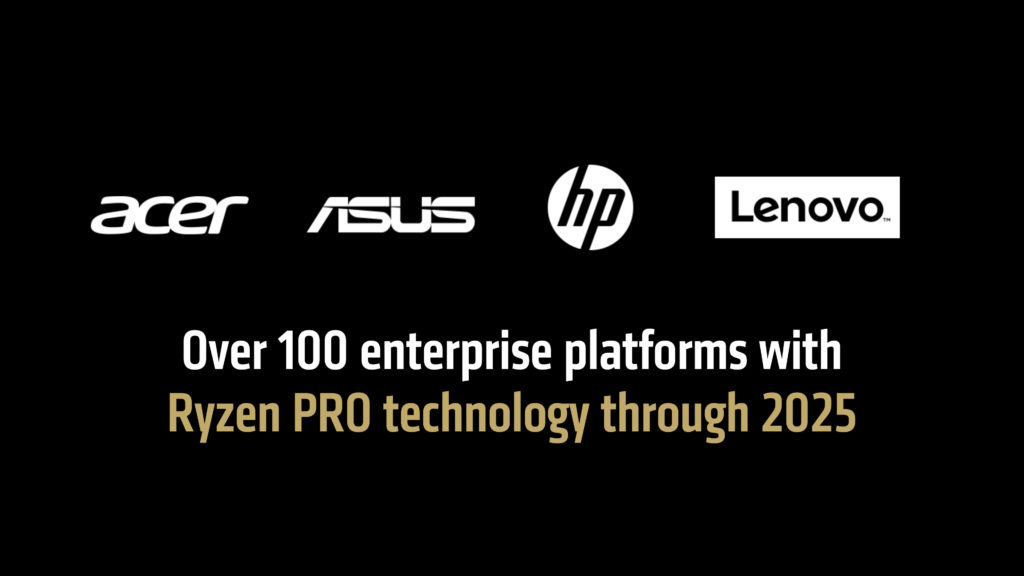
Introduction
AMD is starting the new year off with a bang at CES, announcing a lot of new products coming in 2025 aimed at multiple product segments. For us, and our readers, some of the things we are most excited about will be the announcement of the Ryzen 9 9950X3D and Ryzen 9 9900X3D CPUs, new GPUs based on RDNA 4 technology, and FSR4. Also today, official performance reviews on AMD’s new B850 series chipset launched, and we are kicking off today with our review of the launch with the GIGABYTE B850 AORUS ELITE WIFI7 Motherboard review, so check that out to see what AMD B850 chipset provides.
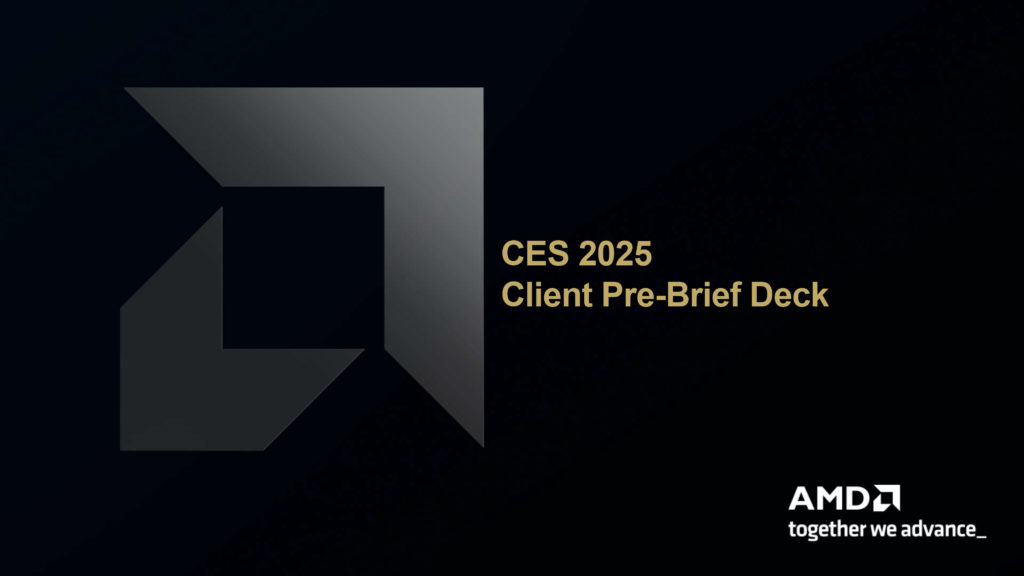
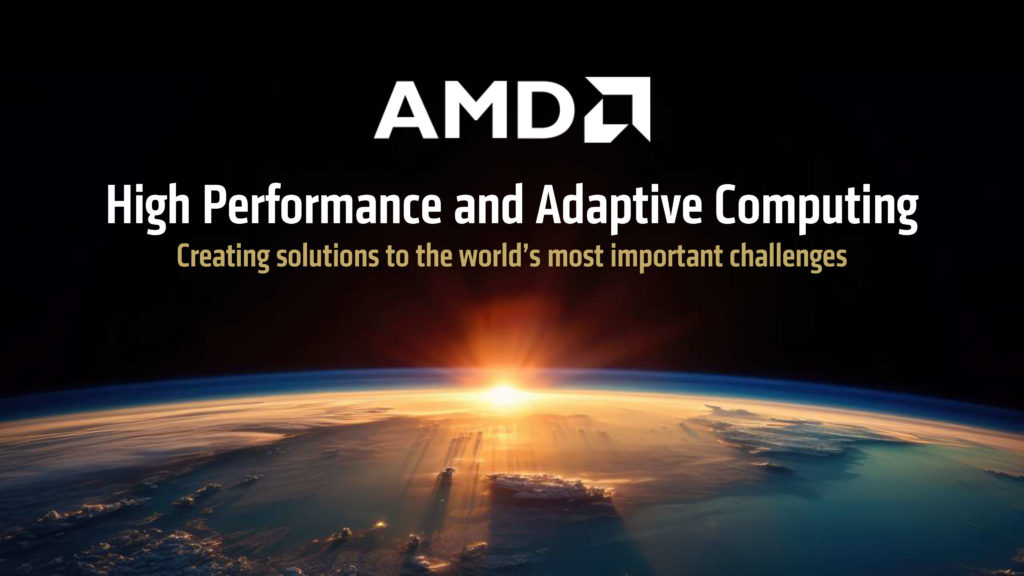
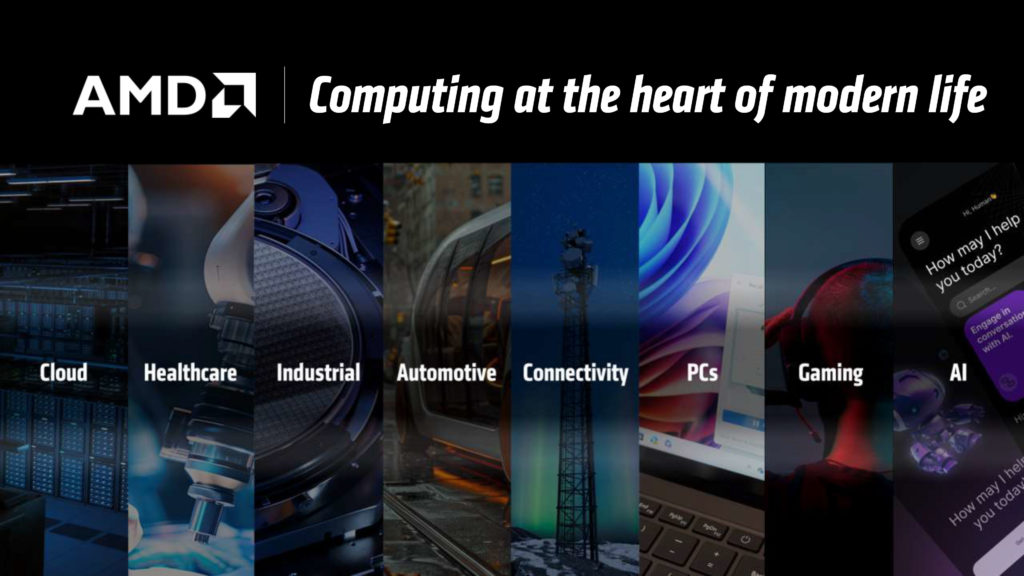
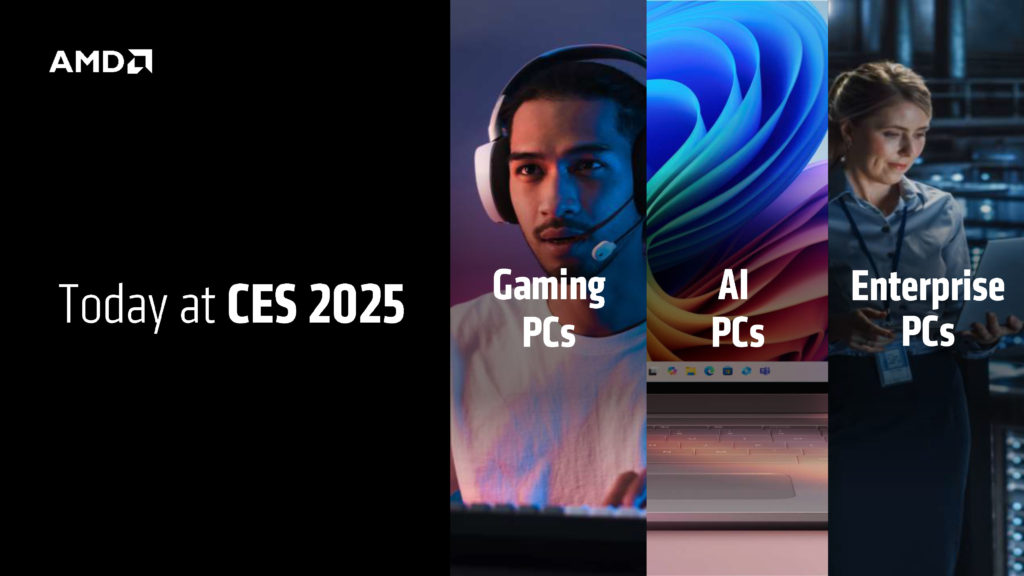
However, there are plenty of other product announcements that will affect a whole range of devices, from powerful mobile processors like the Fire Range HX3D processors, handheld processors such as the Ryzen Z2 series, AMD Ryzen AI, and Ryzen AI PRO 300 series for powerful AI PCs, and Ryzen AI Max and AI Max Pro processors for a new class of AI PC, as well as Ryzen and Ryzen Pro 200 series.
That’s right, most of these announcements today actually involve hardware processor releases coming in 2025, and of course new GPU processors and technology as well. AMD is poised to kick off 2025 strong and fulfill the needs of many different types of users in 2025. Today we are going to publish the entire pre-briefing press deck for your enjoyment, so feel free to browse the entire presentation to see what AMD has to say. We will post some commentary of our own along the way.
AMD Ryzen 9 9950X3D and Ryzen 9 9900X3D
This is probably one of the more expected announcements at CES 2025 from AMD, the announcement of the upcoming AMD Ryzen 9 9950X3D and Ryzen 9 9900X3D CPUs. The AMD Ryzen 7 9800X3D CPU was launched in November of 2024, rounding out the end of 2024 strong for AMD. The AMD Ryzen 7 9800X3D was a flat-out WIN for AMD.
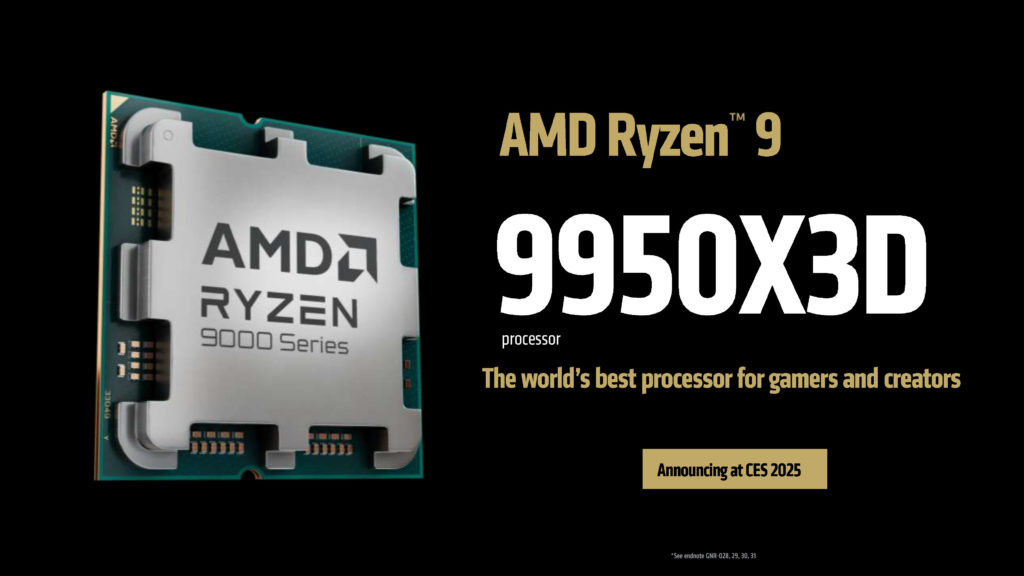

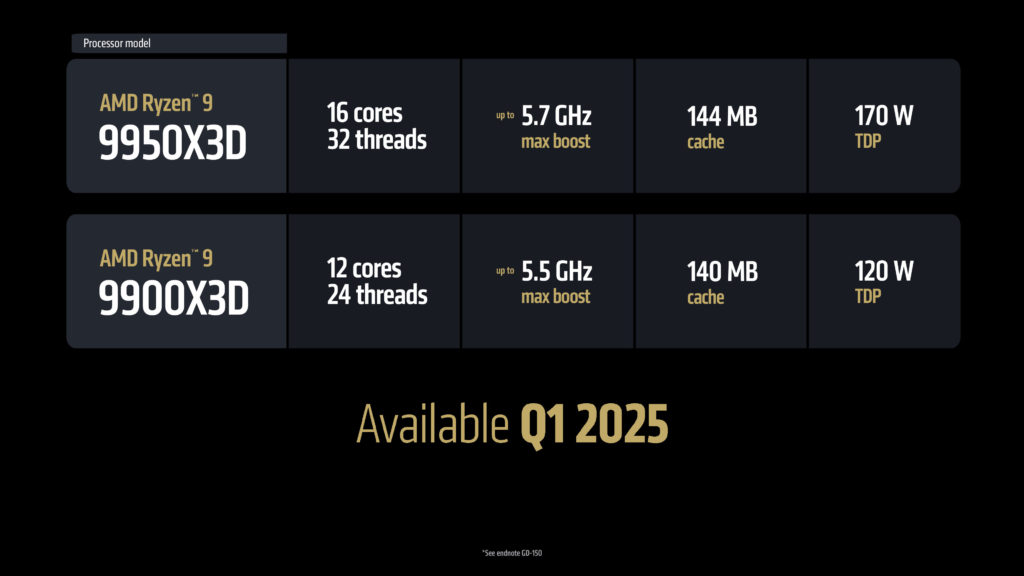
The Ryzen 9 9800X3D introduced AMD’s new 2nd generation 3D V-Cache, which flips the extra L3 cache on its head, positioning it underneath the single-CCD of the 9800X3D. This allowed for the CPU clock frequencies to be maintained at higher frequencies, which resulted in real-world performance improvements.
In our testing, the Ryzen 9 9800X3D did extremely well in content creation, and gaming performance, improving upon the previous generation. It fixed all the problems of frequency that the previous “X3D” CPUs had. Therefore, with the announcement of the AMD Ryzen 9 9950X3D and Ryzen 9 9900X3D, gamers everywhere should be very excited about the potential.
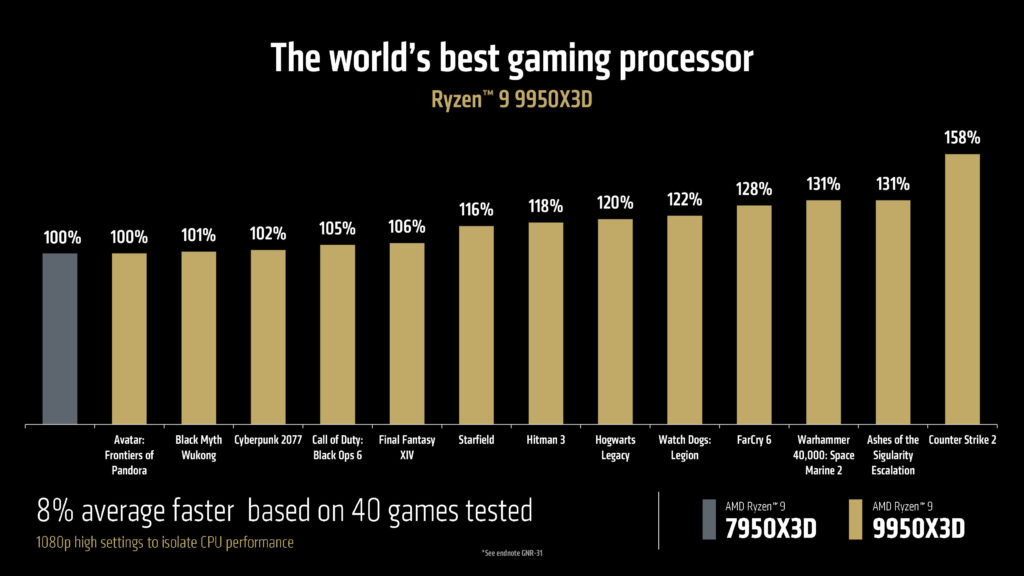
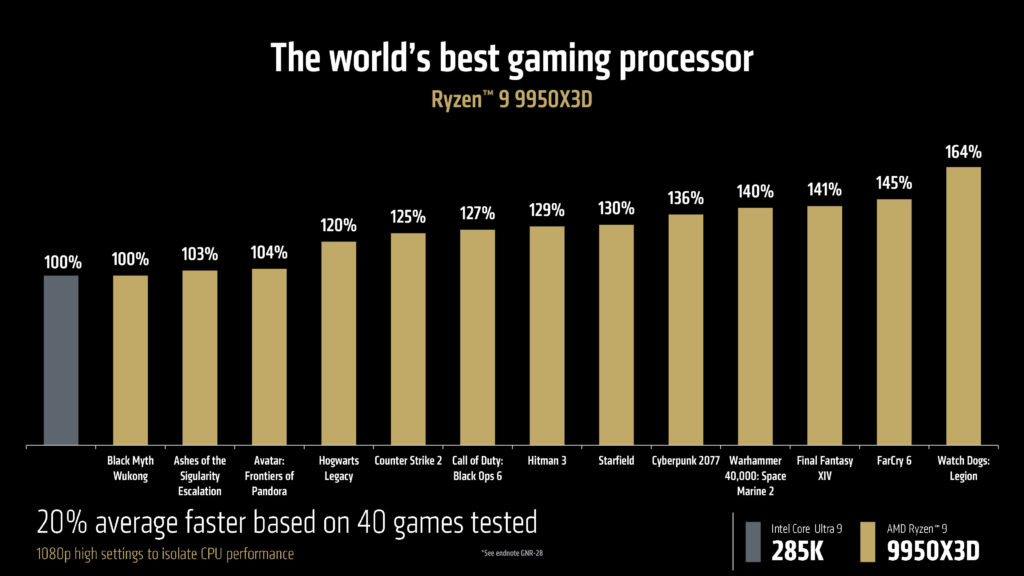

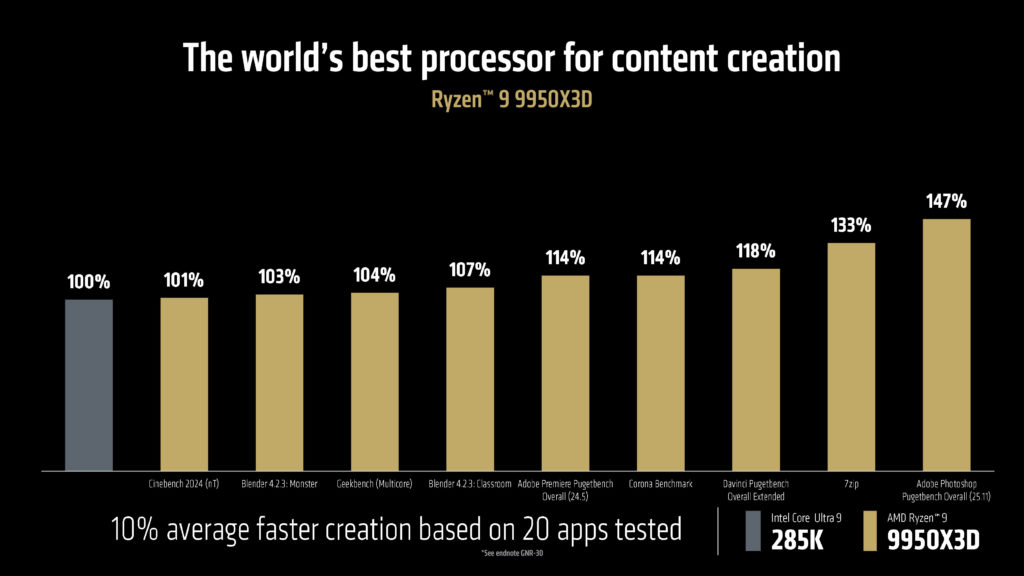
The AMD Ryzen 9 9950X3D and Ryzen 9 9900X3D continue where the Ryzen 7 9800X3D started, by utilizing the same flipped-CCD 2nd generation 3D V-Cache. The important part that you all want to know though is that though the 9950X3D and 9900X3D utilize 2nd generation 3D V-Cache, it is still only on one CCD this generation.
The Ryzen 9 9950X3D is a 16-core/32-thread Zen 5-based CPU that has 144MB of total cache (128MB for L3), and a max boost frequency of 5.7GHz with a TDP of 170W. For comparison, this matches most of the specs of the Ryzen 9 7950X3D also with the same amount of cache, and the same boost frequency of 5.7GHz, however, the 7950X3D only had a max TDP of 120W.
The Ryzen 9 9950X3D increases the TDP to 170W from 120W, and the potential is that the 9950X3D should maintain a higher all-core boost frequency over long periods of time. Also for comparison, the Ryzen 9 9950X has a max boost of 5.7GHz and a TDP of 170W. Therefore, the Ryzen 9 9950X3D does look like the 9950X scaled up with more L3 cache, retaining the same clock boost frequency.
The AMD Ryzen 9 9900X3D is a 12-core/24-thread Zen 5-based CPU that has 140MB of total cache (128MB for L3), and a max boost clock frequency of 5.5GHz with a TDP of 120W. For comparison, the Ryzen 9 7900X3D has the same amount of cache, and a boost clock frequency of 5.6GHz also with a TDP of 120W. Therefore, the new 9900X3D does have a slightly lower boost frequency and the same TDP. Also for comparison, the Ryzen 9 9900X has a boost frequency of 5.6GHz at 120W TDP, so the 9900X3D is clocked just a tad slower.
In performance, AMD is showing the AMD Ryzen 9 9950X3D performing anywhere from the same, up to a 58% performance improvement, though the average is 8%. Therefore, our expectations are set at under 10% for a multi-game average, compared to the 7950X3D. It will naturally depend on the game, and how CPU-dependent it is.
When compared to the Intel Core Ultra 9 285K, AMD is showing the 9950X3D anywhere from on parity, up to 64% faster with an average of 20% faster. For content creation, AMD shows the 9950X no slouch there either, with anywhere from a 4%-23% gain, with an average of 13% uplift over the 7950X3D and 10% faster than the Intel Core Ultra 9 285K. We cannot wait to actually dive into real-world performance when we get these CPUs in hand. Expected availability is Q1 2025.
AMD Fire Range HX3D
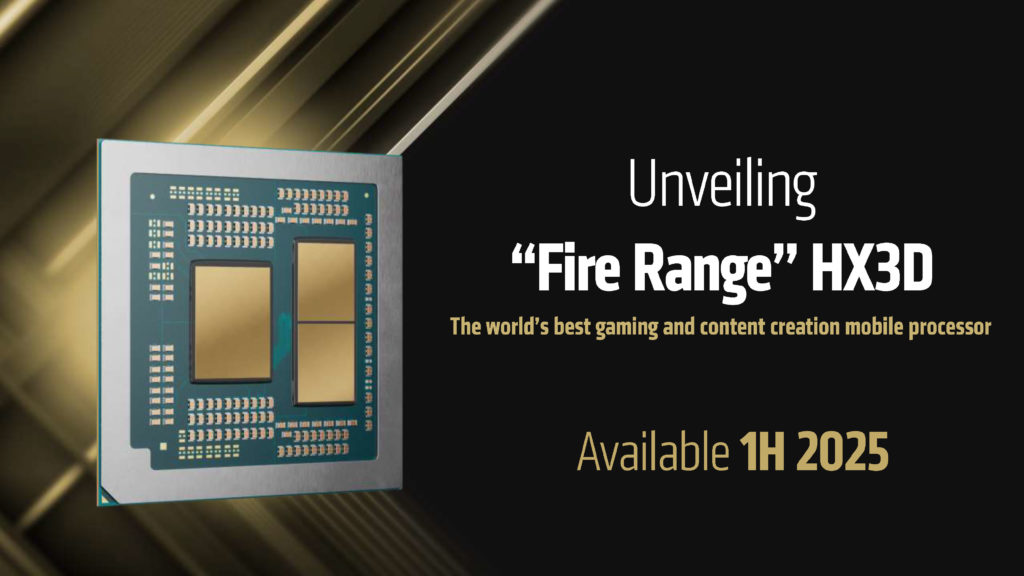
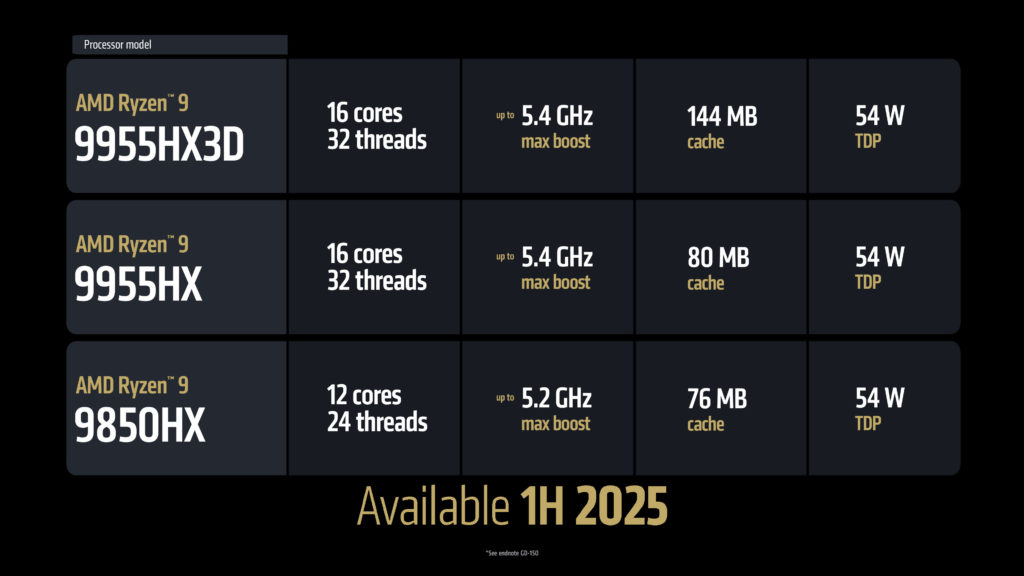
AMD’s “X3D” technology does not stop there, AMD is also announcing three processors for gaming and content creation on mobile processors. AMD’s “Fire Range” processors have that wonderful 3D V-Cache on board for mobile! These will be available 1H 2025. The AMD Ryzen 9955HX3D is a 16-core/32-thread processor with a max boost of 5.4GHz and 144MB of total cache (128MB of L3) in a 54W TDP!
There will also be the AMD Ryzen 9 9955HX and Ryzen 9 9850HX that do not have the extra abundant 3D V-Cache. The Ryzen 9 9955HX is a 16-core/32-thread processor at the same 5.4GHz boost, and 54W TDP but without the extra 3D V-Cache. The Ryzen 9 9850HX is a 12-core/24-thread processor with a 5.2GHz max boost and also at 54W TDP. That 9955HX3D is a very appealing processor if you must have the most powerful gaming laptop! Having 3D V-Cache in a mobile processor is extremely exciting for the performance potential, where it really matters in a constrained TDP.
AMD RDNA 4 Architecture
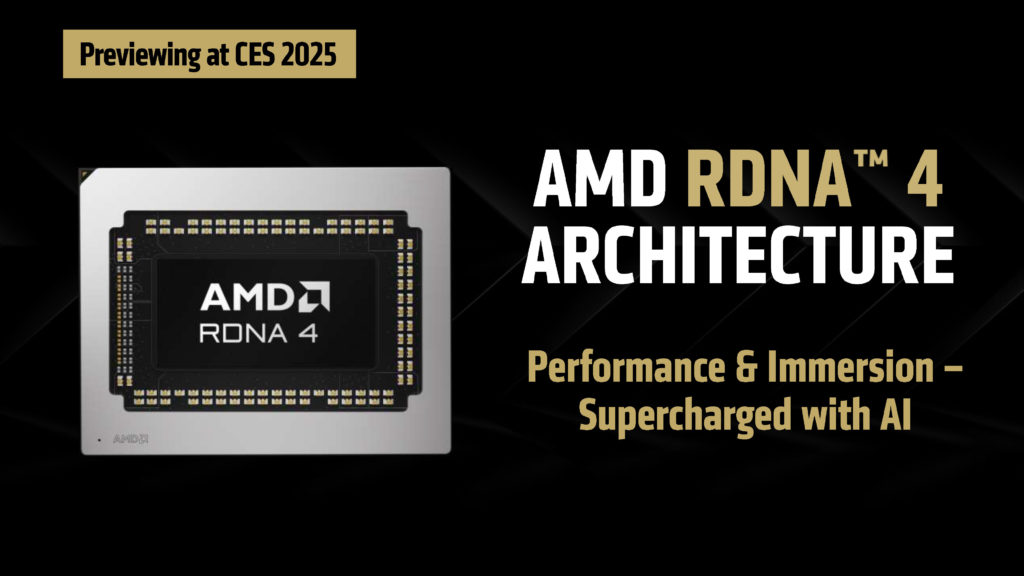
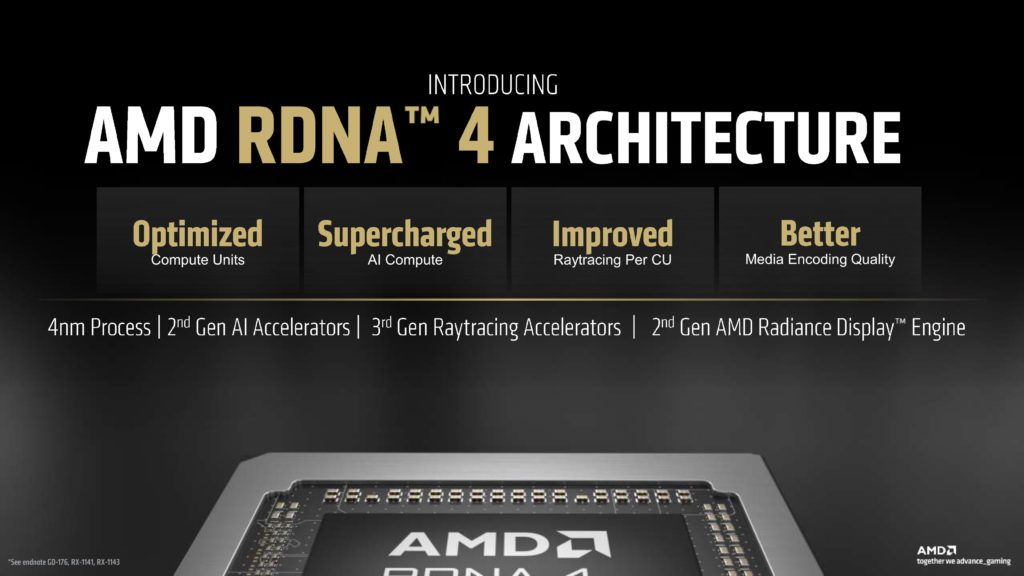
AMD’s next-generation GPU technology, RDNA 4, was also not a huge surprise of getting an official announcement this CES, and AMD is in fact announcing its next-generation GPUs coming in 2025. We do not know a whole lot about the new architecture yet, but we know that it is coming, and we know that AI processing will be a big part of it. AMD states optimized compute units, supercharged AI compute, improved Ray Tracing per CU, and a better media encoder. There are a few big-picture hardware facts, such as the 4nm process, 2nd-gen AI accelerators, 3rd-gen Raytracing accelerators, and 2nd-gen AMD Radiance display engine, but that’s pretty much all we know at this point.
FSR 4
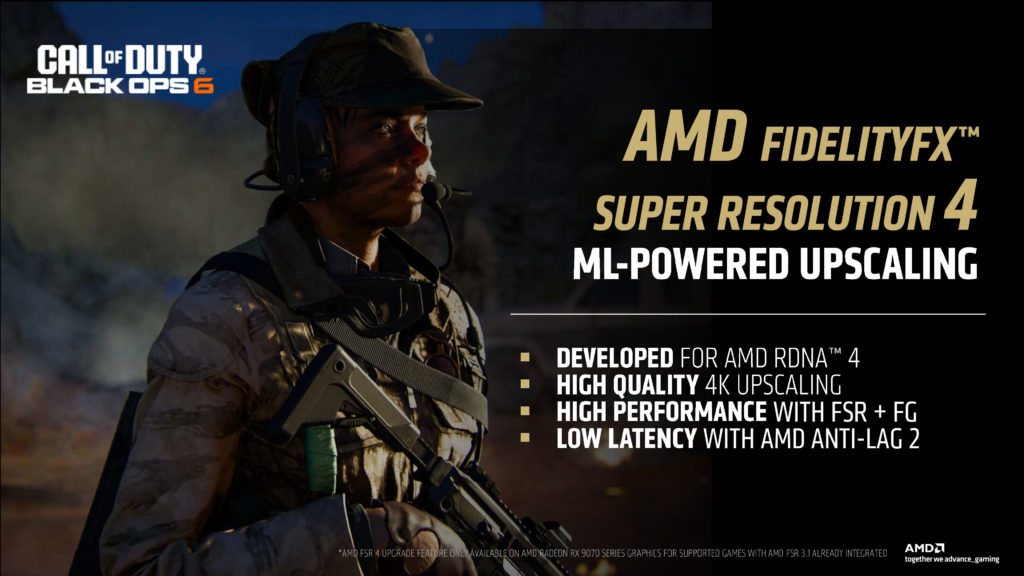
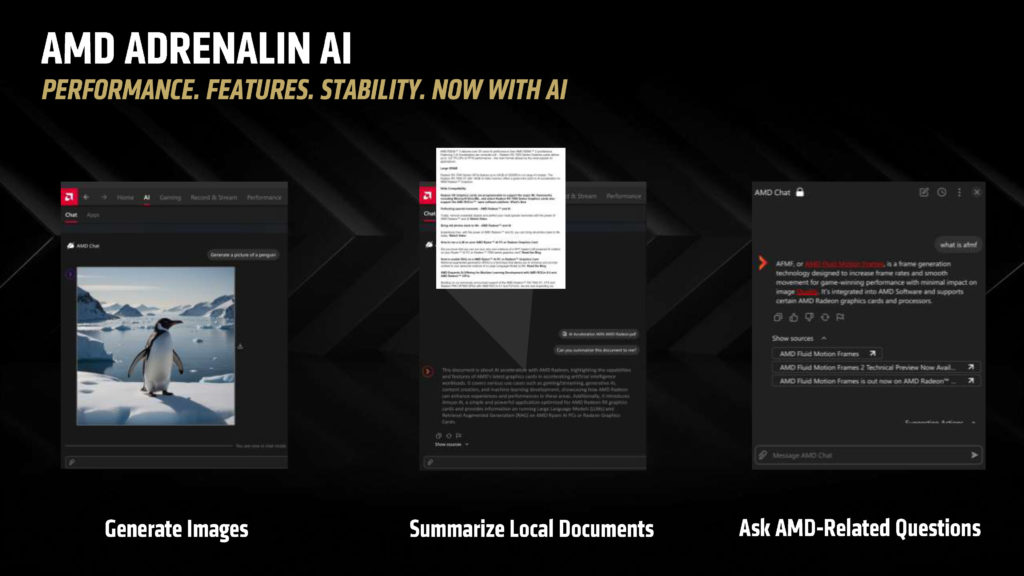
AMD is also finally ready to officially announce that AMD FidelityFX Super Resolution 4 (FSR 4) is coming to RDNA 4 architecture GPUs. We also do not know a lot about this, other than that it is developed for AMD RDNA 4 and will be ML-Powered for upscaling. It is stated to allow high-quality 4K upscaling, and high performance with FSR + FG, and will work with AMD Anti-Lag 2. We do not know if it is restricted to just RDNA 4, but that line about “developed for AMD RDNA 4” certainly leans into that direction.
AMD Radeon RX 9070 XT and Radeon RX 9070
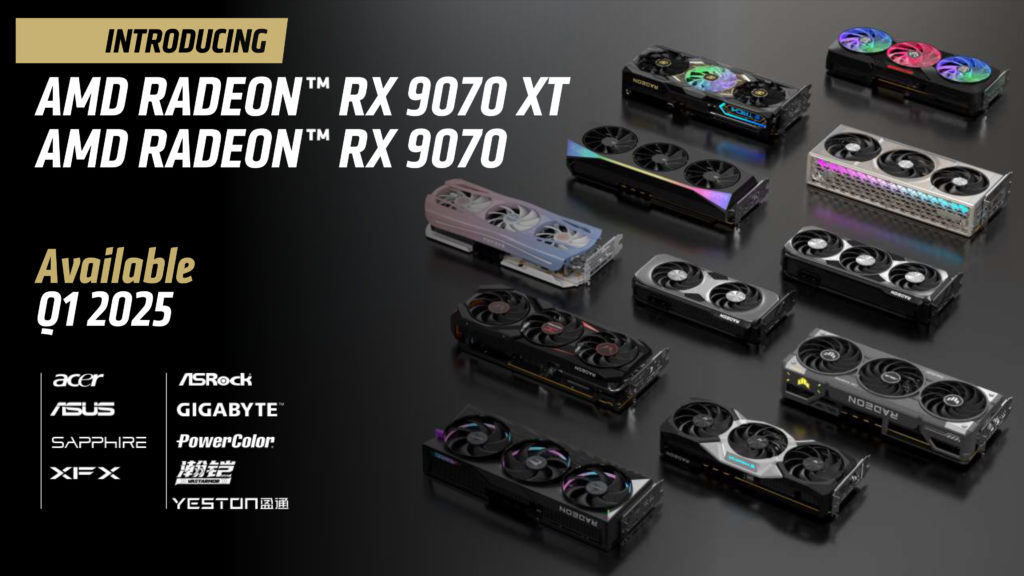
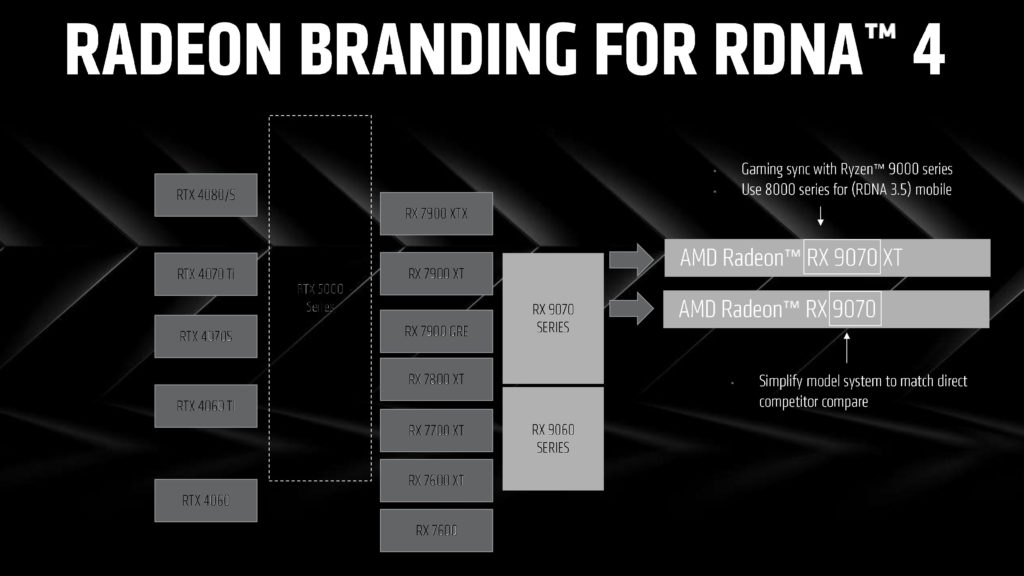
The first two video cards that AMD will be launching based on the RDNA 4 architecture is the new AMD Radeon RX 9070 XT and Radeon RX 9070. Video cards based on these GPUs will launch in Q1 2025 from the various manufacturers. That’s right, AMD is officially changing the brand numbering on its Radeon GPUs for this new generation of RDNA 4. Instead of the previous Radeon RX 7000 series, AMD is jumping up to the 9000 series with this generation, and re-arranging the branding numbering. The AMD Radeon 8000 series will be reserved for RDNA 3.5 products that already exist, AMD wanted to separate the two so it wouldn’t be confusing between those mobile parts, and the discrete GPU products.
We don’t know what performance is like yet, however, AMD is showing that it is positioning the Radeon RX 9070 XT and Radeon RX 9070 between the Radeon RX 7900 GRE and Radeon RX 7900 XT and GeForce RTX 4070 Super to GeForce RTX 4070 Ti in product positioning. AMD is also showing the Radeon RX 9060 series existing somewhere upwards of the Radeon RX 7600 XT to Radeon RX 7700 XT or Radeon RX 7800 XT and GeForce RTX 4060 Ti.
AMD Ryzen Z2 Series Processors
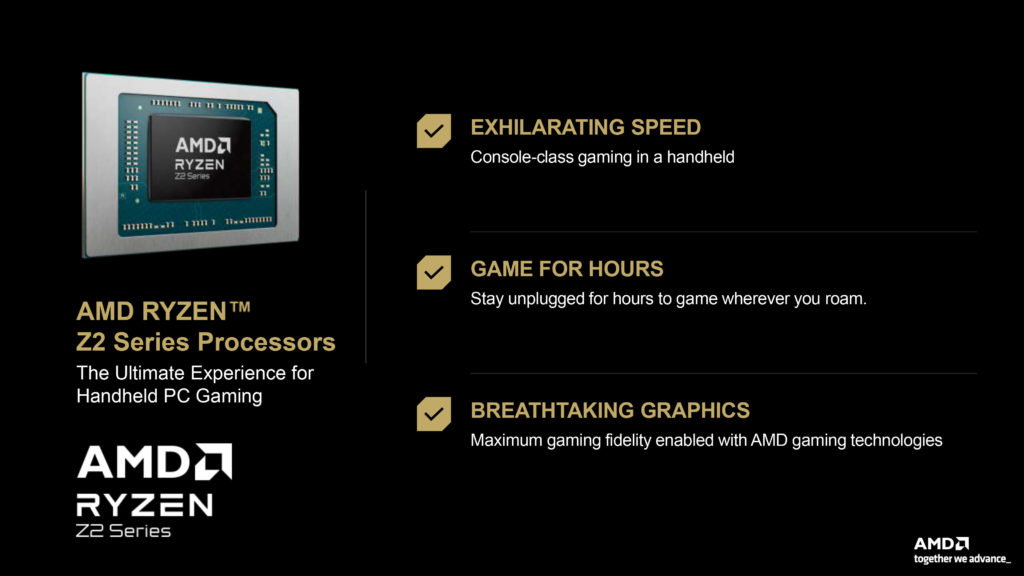
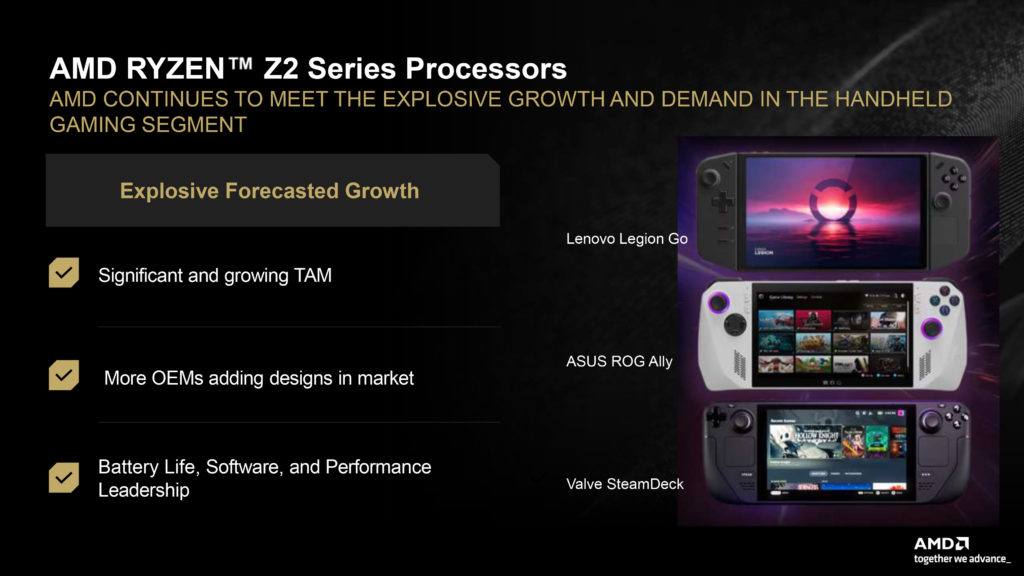
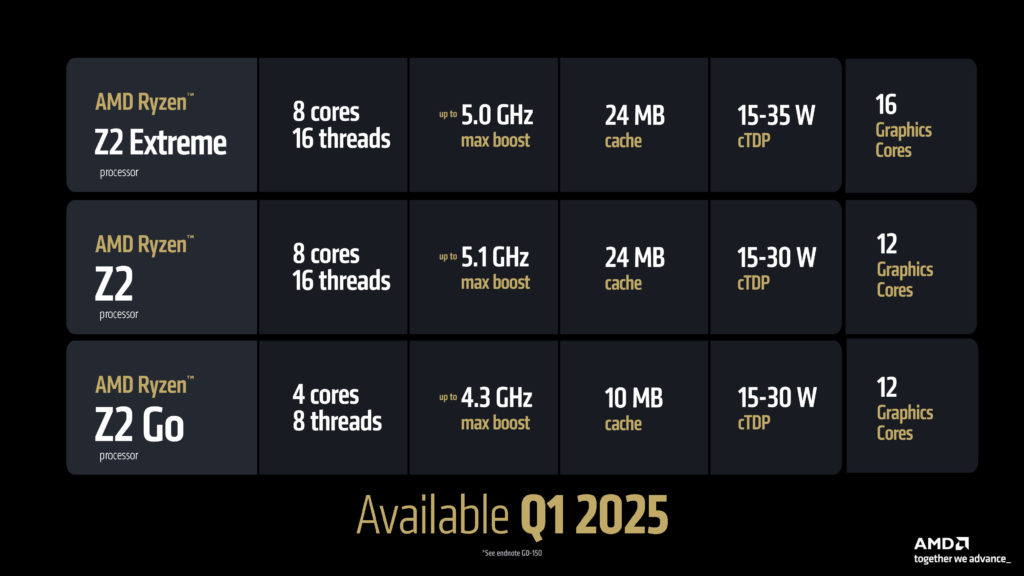
AMD is also announcing the AMD Ryzen Z2 Series Processors at CES 2025 for the ultimate experience in handheld PC gaming. These will provide console-class gaming in a handheld, longer play times, and great graphics. The products start at the top with the AMD Ryzen Z2 Extreme which is an 8-core/16-thread processor with a max boost of 5GHz and 24MB of cache in a 15-35W TDP with 16 graphics cores. The AMD Ryzen Z2 is an 8-core/16-thread processor up to 5.1GHz and 24MB of cache between 15-30W TDP with 12 graphics cores. The AMD Ryzen Z2 Go is a 4-core/8-thread processor up to 4.3GHz and 10MB of cache between 15-30W with 12 graphics cores. All of the graphics are based on the RDNA 3 architecture.
AMD Ryzen AI and AI Pro 300 Series
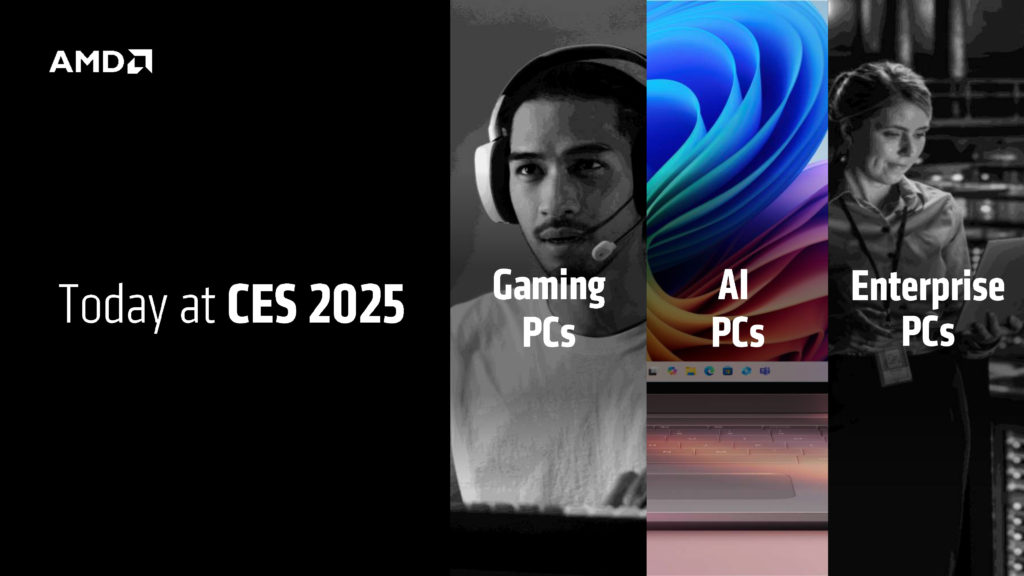
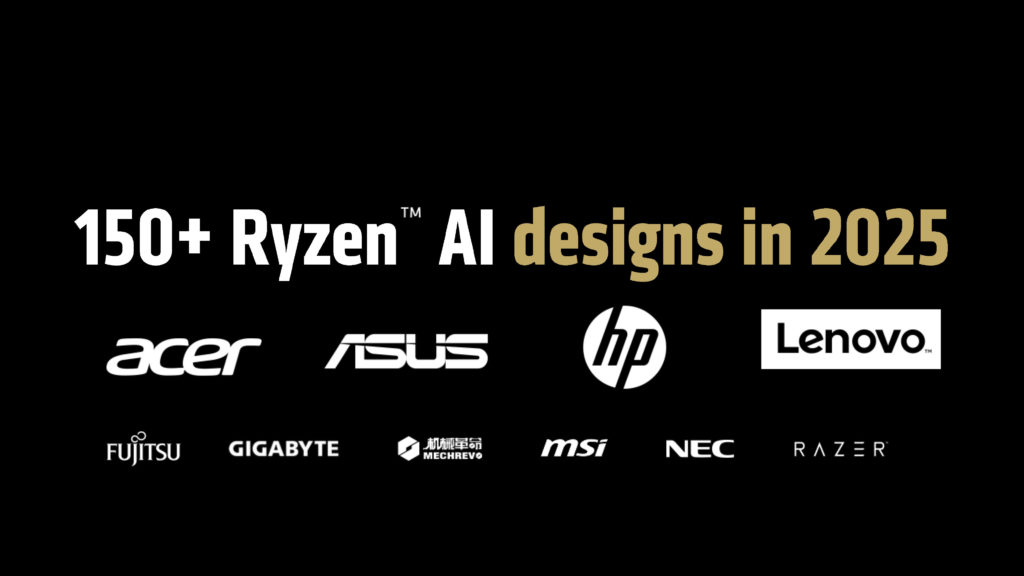
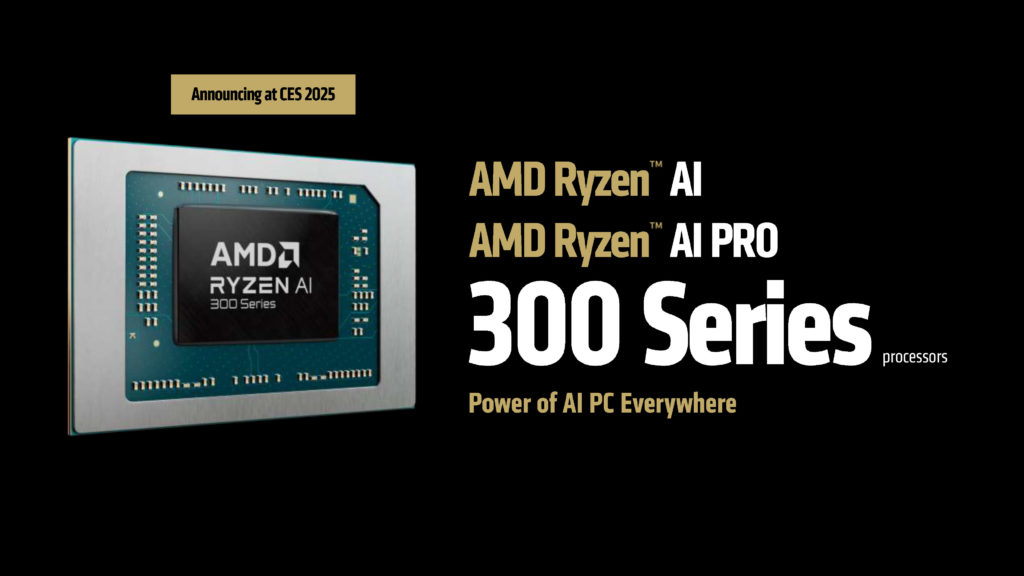
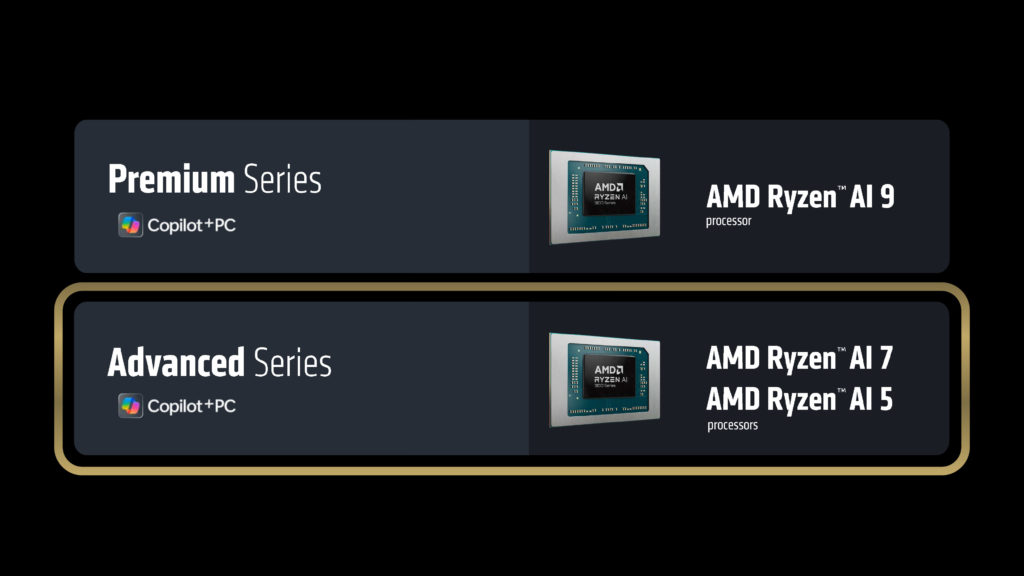
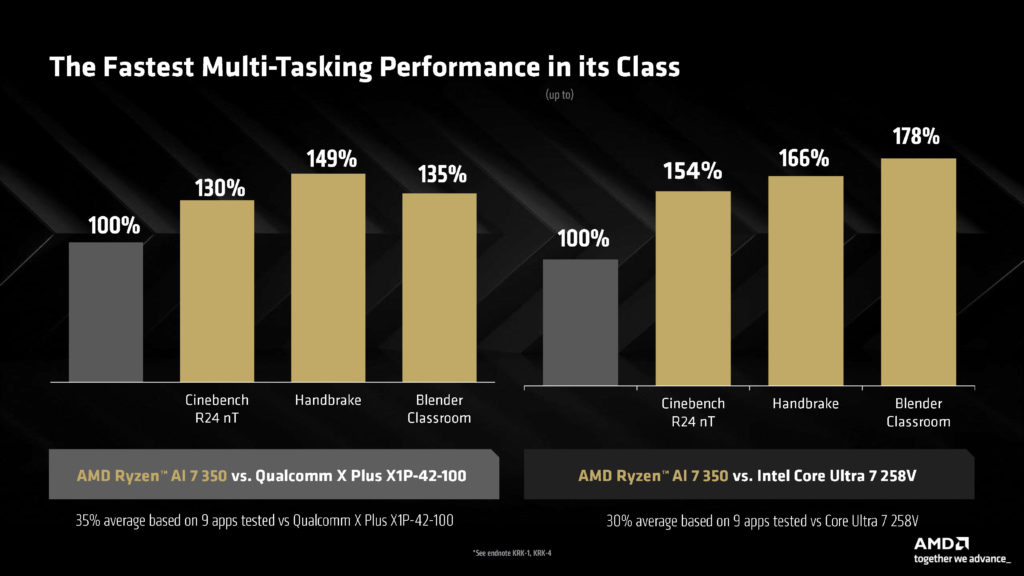
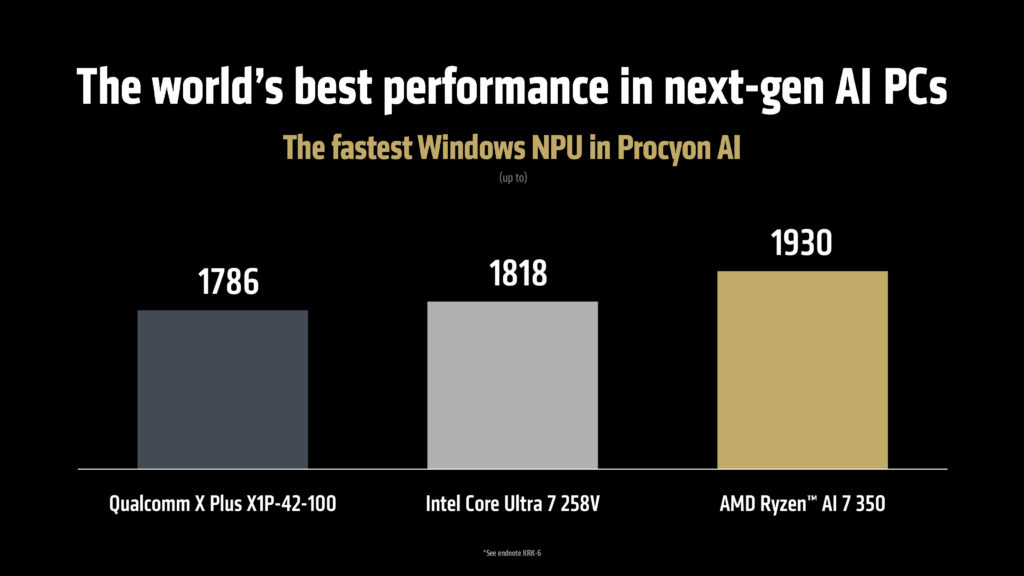

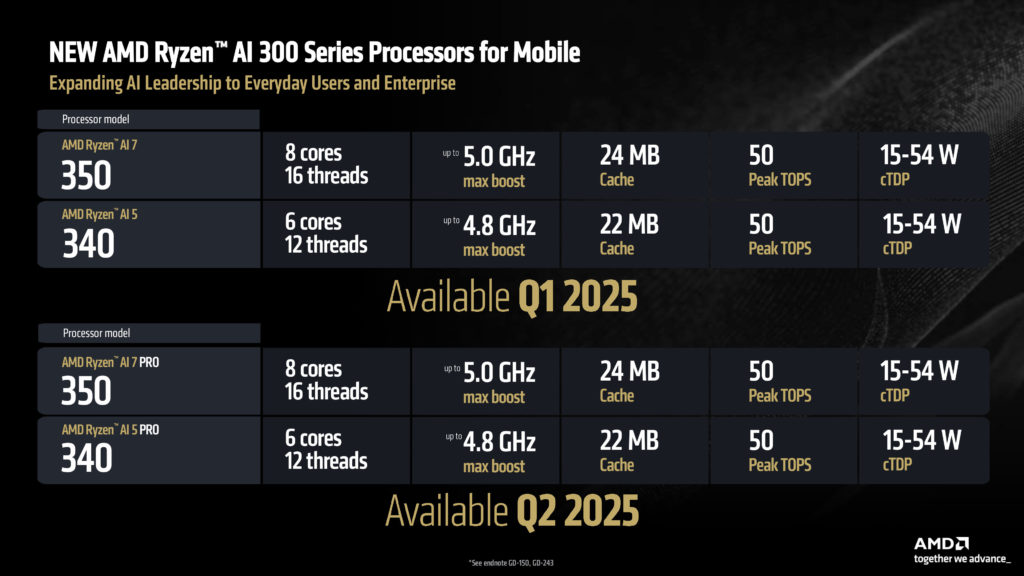
It would not be a CES if we didn’t talk about AI processors. AMD is announcing the AMD Ryzen AI and AMD Ryzen AI PRO 300 series of processors for the power of AI PC everywhere, reaching into many devices. The AMD Ryzen AI 9 is aimed at the premium Copilot+PC while the AMD Ryzen AI 7 and Ryzen AI 5 are aimed at the advanced series of Copilot+PCs. The AMD Ryzen AI 7 350 is an 8-core/16-thread processor with a max boost of 5GHz and 24MB of cache with 50 peak TOPS in a 15-54W form factor. The AMD Ryzen AI 5 340 is a 6-core/12-thread processor with a 4.8GHz boost and 22MB of cache with 50 peak TOPS and 15-54W. These are available in Q1 2025.
The AMD Ryzen AI 7 PRO 350 is an 8-core/16-thread processor with a max boost of 5GHz and 24MB of cache with 50 peak TOPS in a 15-54W form factor. The AMD Ryzen AI 5 PRO is a 6-core/12-thread processor with a 4.8GHz boost and 22MB of cache with 50 peak TOPS and 15-54W. These will be available in Q2 2025. All cores are based on Zen 5 architecture.
AMD Ryzen AI Max and Ryzen AI Max PRO
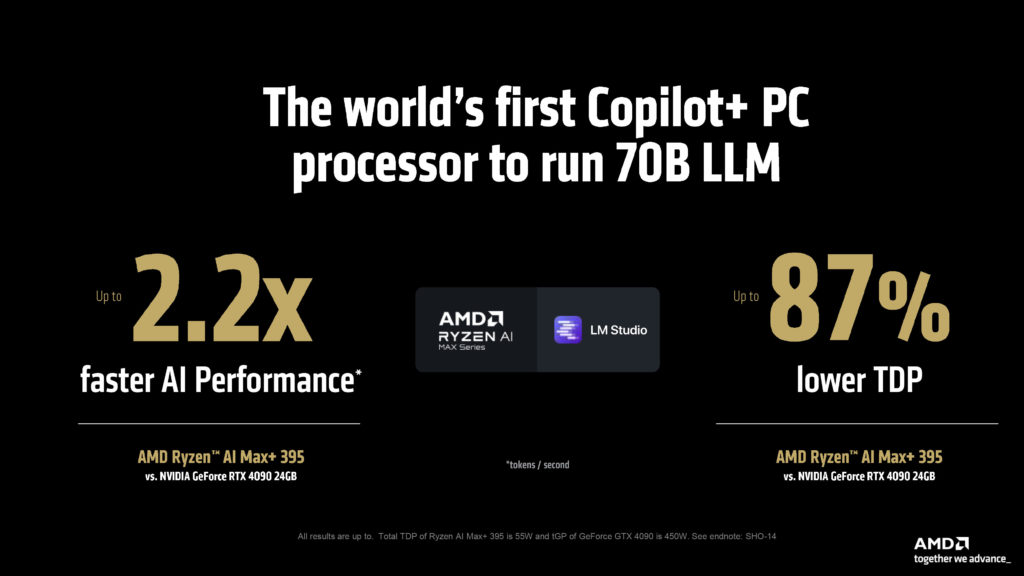
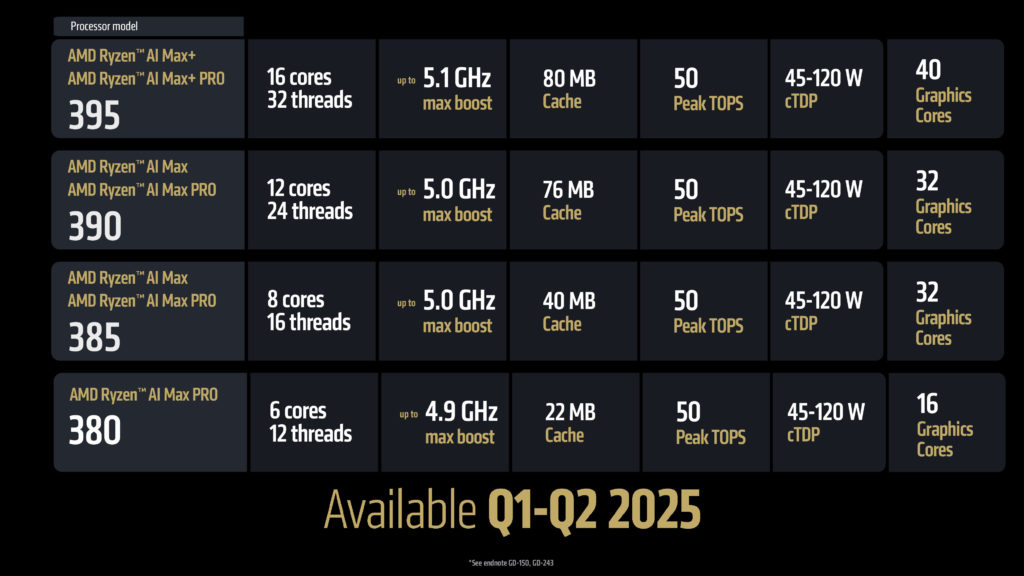
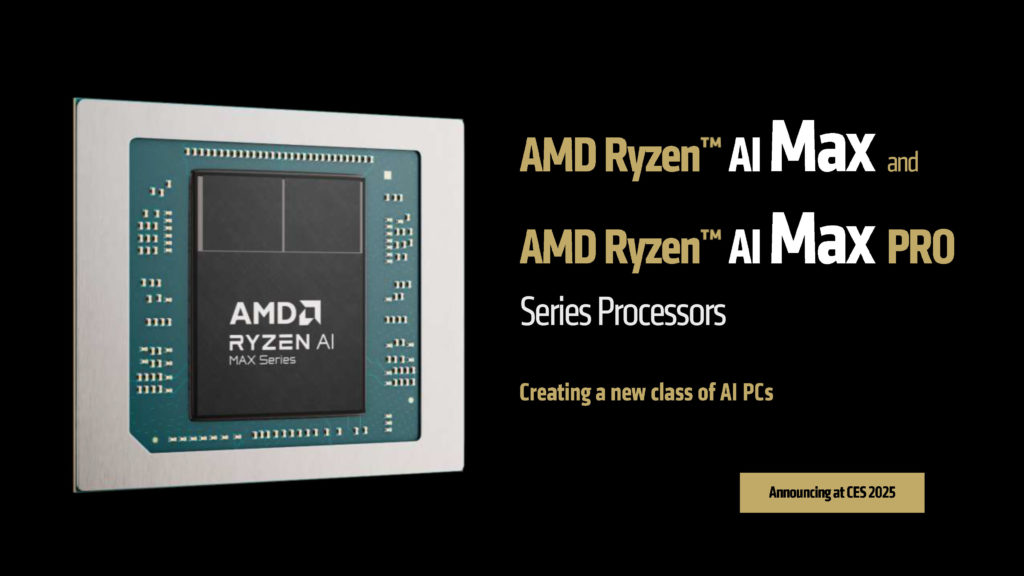


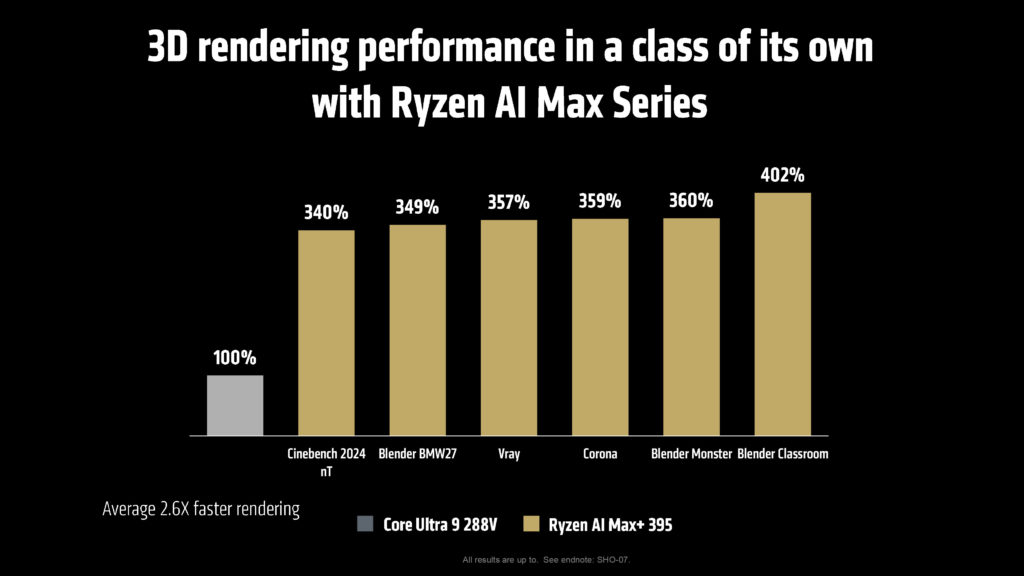
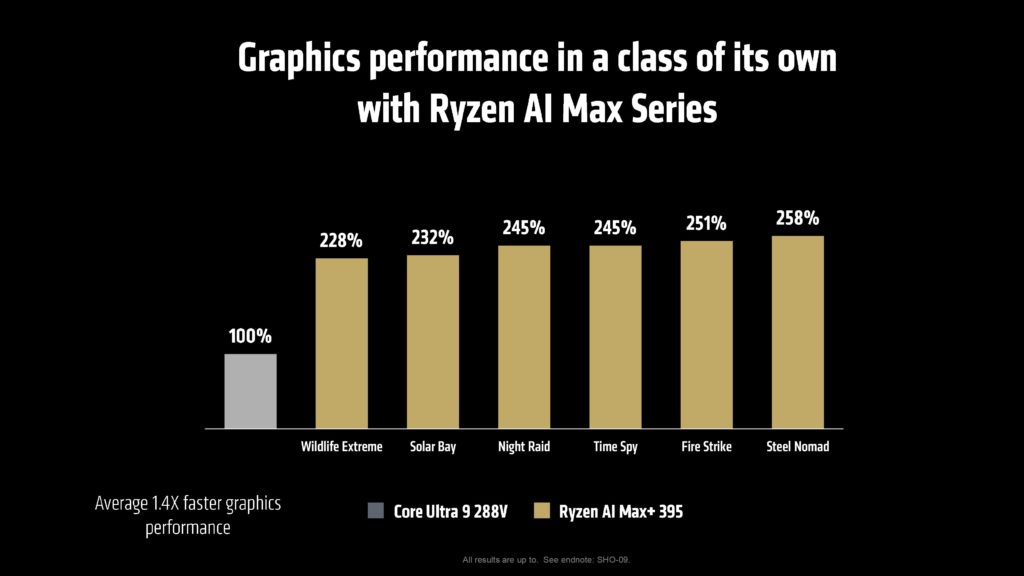
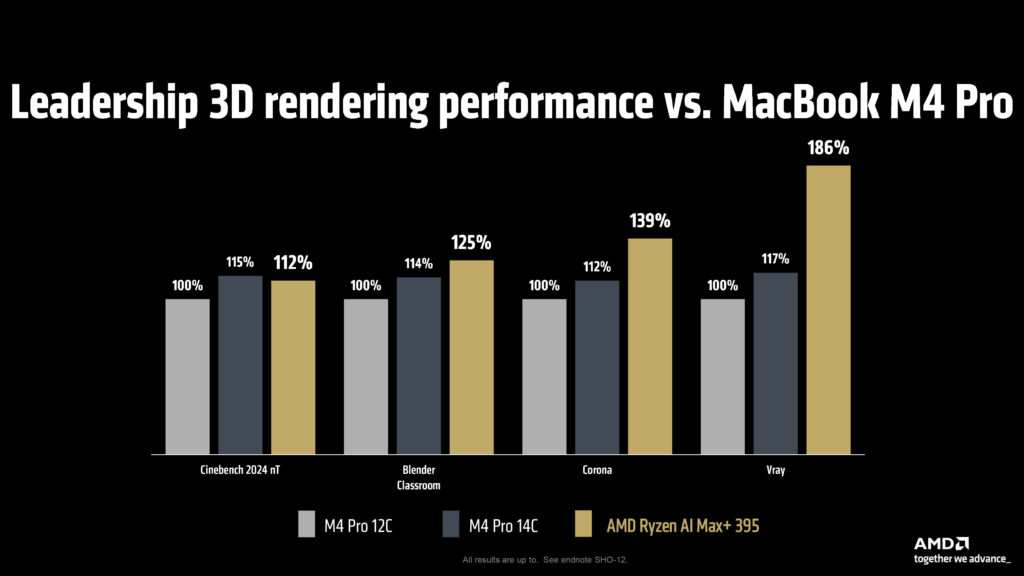
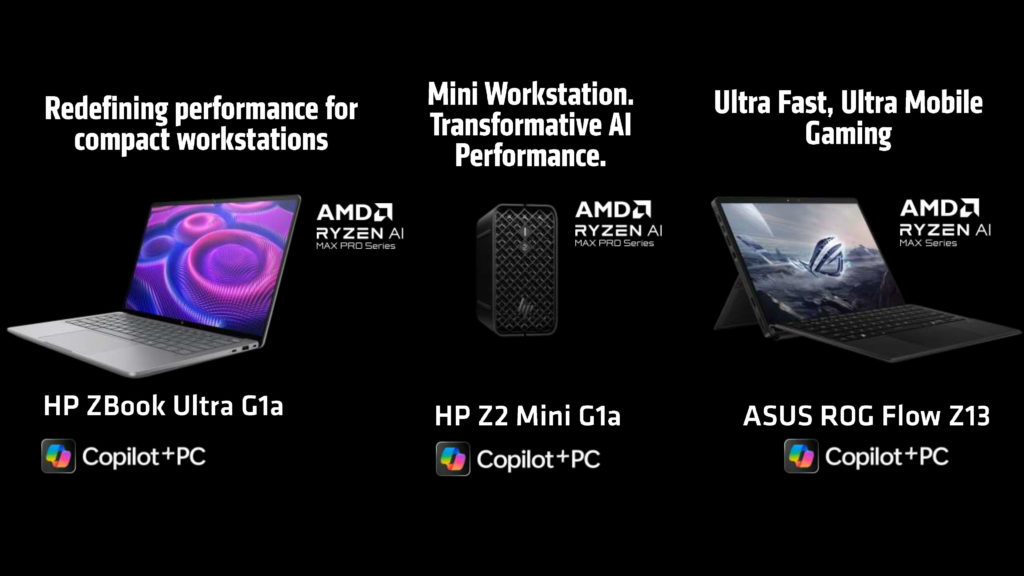
The AI train doesn’t stop there, oh no, it does not. AMD is announcing at CES 2025 the AMD Ryzen AI Max and AMD Ryzen AI Max PRO series processors for creating a whole new class of AI PCs, for high-end. The AMD Ryzen AI Max+ and AMD Ryzen AI Max are aimed at a special halo tier product series of Copilot+PC, this sits above the Ryzen AI 9 and Ryzen AI 7, and AI 5 for a high-end product that should just be really powerful. All of these are also based on the Zen 5 architecture.
The AMD Ryzen AI Max+ and Ryzen AI Max PRO series use 16 Zen 5 class cores, 40 RDNA 3.5 compute units, up to 50 TOPs with XDNA 2 NPUs, and up to 256GB/s of memory bandwidth. The real exciting part here is the 40 RDNA 3.5 compute units, this could mean discrete-level GPU performance in a slim and efficient mobile/small form factor/mini-PC format. In performance, AMD is showing the Ryzen AI Max+ 395 average 2.6x faster than the Core Ultra 9 288V in content creation and 1.4x faster in graphics performance, and it also rivals the M4 Pro 12C and M4 Pro 14C.
There are many SKUs here, the AMD Ryzen AI Max+ and Ryzen AI Max+ PRO 395 have 16-cores/32-threads at 5.1GHz boost and 80MB of cache, 50 TOPS, at 45-120W TDP, and 40 graphics cores. This one will be the most desirable if gaming performance in the smallest form factor is what you are after. The Ryzen AI Max 390 and Ryzen AI Max PRO 390 are 12-core/24-thread processors at 5GHz with 76MB of cache, 50 TOPS and 45-120W TDP with 32 graphics cores.
The Ryzen AI Max 385 and Ryzen AI Max PRO 385 are 8-core/16-thread processors at 5GHz with 40MB cache, 50 TOPS, 45-120W TDP and 32 graphics cores. The AMD Ryzen AI Max PRO 380 is a 6-core/12-thread processor with up to 4.9GHz, 22MB cache, 50 TOPS, 45-120W TDP, and 16 graphics cores. Remember, these are all Zen 5 processors as well, and RDNA 3.5.
AMD Ryzen and Ryzen PRO 200 Series

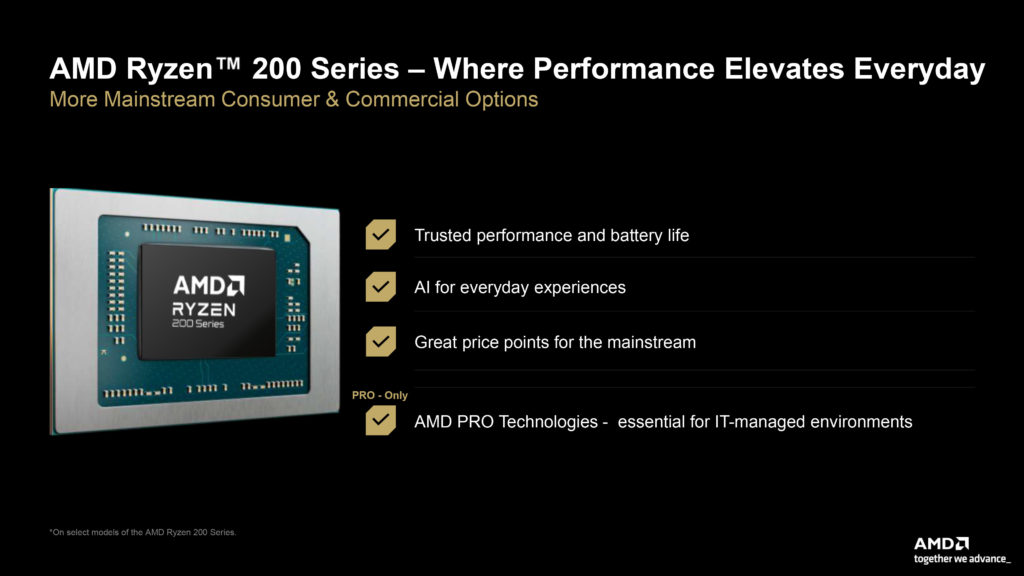

Rounding out the product announcement the AMD Ryzen and Ryzen PRO 200 series. These provide more mainstream and consumer and commercial options. A lot of products here, available in Q2 2025, AMD Ryzen 9 270, Ryzen 7 260 and Ryzen 7, and Ryzen 7 PRO 250 are 8-core/16-thread processors, the fastest at 5.2GHz, the others at 5.1GHz with 24MB of cache, 16 peak NPU TOPS, and TDPs from 15-54W at the highest.
The AMD Ryzen 5 240, Ryzen 5 and Ryzen 5 PRO 230, and Ryzen 5 and Ryzen 5 PRO 220 are 6-cores/12-threads at 4.9-5GHz with 22MB of cache and 16 peak TOPS at 15-30W. However, the Ryzen 5 and Ryzen 5 PRO 220 and 210 do not have the NPU. The AMD Ryzen 3 and Ryzen 3 PRO 210 are 4-cores/8-threads at 4.7GHz, 12MB cache, and 15-30W TDP.
Enterprise
Conclusion

This one slide sums it all up, AMD is starting off 2025 by going hard on product launches planned for 2025. Unfortunately, right now, there are no official launches or launch dates, just announcements of upcoming products and general windows of quarter or year-halfs that these will be coming this year.
For our audience, the culmination of the AMD Ryzen “X3D” CPUs will be most exciting. The AMD Ryzen 9 9950X3D looks interesting, though we know many people will be disappointed about AMD not pushing the 3D V-Cache to both CCDs. In this generation, it seems that 3D V-Cache will remain on a single-CCD for the 9950X and 9900X3D.
However, the flipping of the cache should allow higher sustained clock speeds for gaming, or all-core multi-threading workloads at least. This should help the 9950X3D and 9900X3D not fall back in performance below their non-X3D parts, we think. There will still be the reliance on AMD’s PPM Provisioning driver, core parking, and 3D Optimization drivers as well as Windows XBOX Game Bar, however.
We are also very excited to see what AMD’s RDNA 4 architecture GPUs offer this generation. There have been a lot of rumors about vastly improved Ray Tracing performance per CU, so if that is true, it could be very exciting. It is a fact that AMD will not have a high-end GPU this generation, to compete with the GeForce RTX 5090, or even RTX 5080. AMD does seem to be targeting the current range up to the Radeon RX 7900 XT and GeForce RTX 4070 Ti in performance, therefore the key for AMD will be to price these video cards right in order to provide value this generation.
It will be tough, AMD will be going up against NVIDIA’s next-generation Blackwell GPUs as well, so pricing will be EVERYTHING this generation from AMD, let’s hope they impress, and don’t get greedy. The name change, it’s a little confusing, but we understand why, on one hand, they don’t want to confuse these video cards with the RDNA 3.5 products, and on the other hand if you won’t have a super-high-end product, then changing the branding this generation helps to remove comparisons from the previous naming and expectations.
FSR 4 also sounds promising, finally, it seems that AMD will be providing a machine learning-enhanced upscaling algorithm. It is about time, as well, as good as FSR was, it was just never going to compete with the competition with its current implementation. Machine learning, and training, is necessary to provide the best image possible, as good as DLSS is even, it still isn’t perfect either, so to achieve the best it can be, AMD had to do the same.
What we do not know is if this will be completely restricted to RDNA 4 GPUs, or not, but my gut says it will? I would certainly understand if it was an exclusive feature to RDNA 4, for it to be accelerated well without degrading performance, it would need to un-burden the compute units, and this can only be done with dedicated hardware like NVIDIA has. It does make sense, even if you don’t like the restriction. But we will see, we haven’t been briefed on it specifically, and there will be a lot more to learn over time before the launch.
There are also two more exciting products we are looking forward to, the Fire Range processors sound exciting, specifically the AMD Ryzen 9 9955HX3D with 3D V-Cache. We are also excited about what the Halo product of AMD Ryzen AI Max+ and AMD Ryzen AI Max can provide. With 16-cores/32-threads of Zen 5 cores and 40 RDNA 3.5 compute units, and high memory bandwidth, these are indeed exciting products for integrated graphics performance. We could see some really fast gaming options in small form factors, or in the mini-PC space.
Overall, AMD is hitting it off strong, now we just need it all to launch, and the key point is actually to actually be available with plenty of stock, and competitive pricing. Pricing will be key for AMD this generation in the GPU space, so let’s see how they answer that call this generation. Also, don’t miss our launch review of the AMD B850 chipset series with our GIGABYTE B850 AORUS ELITE WIFI7 Motherboard review.

